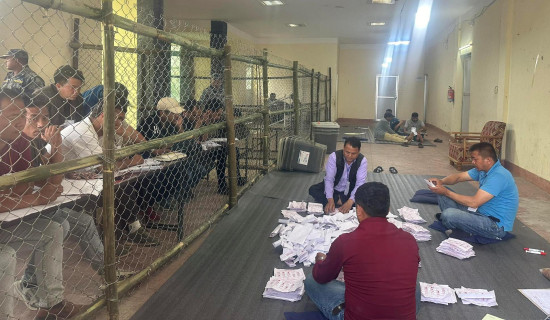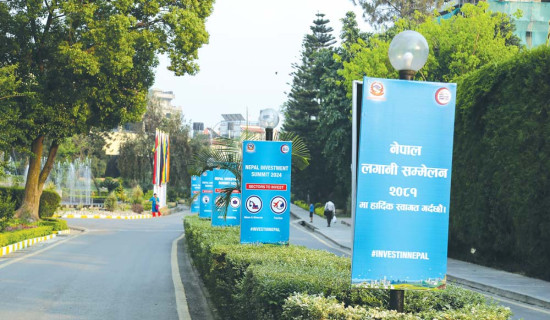- Tuesday, 30 April 2024
Time To Adopt Climate-smart Agriculture
Many developing countries have included Climate-smart Agriculture (CSA) in their Nationally Determined Contributions (NDCs) under the United Nations Framework Convention on Climate Change (UNFCCC) Paris Agreement. There are a growing number of national climate change plans and strategies that outline adaptation and mitigation measures for agriculture and food systems. Nepal is one of the developing countries that has explicitly incorporated CSA in its NDCs. The National Adaptation Programme of Action (NAPA), National Adaptation Programmes (NAPs), National Appropriate Mitigation Action (NAMA) at the national level, and Local Adaptation Plan of Action (LAPA) at the local level are all examples of policies, programmes, and strategies related to climate change that in some way incorporate CSA.
CSA principles and approaches have also been included in agricultural development plans and strategies. Although the CSA approach is appealing and convincing in theory, its implementation in Asia's different agroecologies and farming systems, socioeconomic conditions, and policies still requires tangible examples of success. It is crucial to have proof of how such successes are determined and attained. The ability to glean clear empirical messages to inform farmers and policymakers, as well as support any scaling-up initiatives, will be dependent on how the CSA concept is understood in practice, allowing for adaptations and continuous two-way feedback mechanisms between researchers and practitioners, farmers and policymakers.
In various areas of Nepal, most impoverished farmers, including women, have weak and unsecured water and land rights. Existing customary and institutional reasons, as well as new ones, such as large-scale foreign investment in agricultural land, which causes displacement of present impoverished land users, have aggravated the situation. At another level, a lack of accurate and timely information and technical advisory services, as well as a lack of availability and access to inputs, particularly suitable crop varieties, limit their capacity to assess the risks and advantages of climate-smart agriculture and make educated investment decisions. In the agricultural dimension, competing resource utilisation has been a key constraint. Furthermore, smallholders confront specific challenges in accessing domestic, regional, and worldwide markets. “Farmers in Nepal face significant risks as a result of climatic hazards, but they also face the challenge of managing risks associated with the high costs (at least initial costs) of adopting new technologies (e.g., conservation agriculture and agro-forestry), the benefits of which often come after several years or seasons of production. The majority of farmers have little or no recourse to credit, microfinance, or insurance."
Not only that, but the coordination and integration of policies and programmes have proven difficult in this environment. For example, the Multi-Stakeholder Climate Change Initiatives Coordination Committee (MCCICC) did not meet regularly.
The institutional frameworks required for climate-smart agriculture to scale up from the farm to the landscape are lacking. In the Nepali context, as an agriculturally-based country with more than 57.3 per cent directly related to it and largely affected by climate change impacts every year, it is critical to have specific sections on climate-smart technologies and climate-smart policies, both at the national and local levels, which are currently lagging. The inability to get and buy seeds, inorganic fertilisers, pesticides, and herbicides limits the implementation of CSA most productively. Smallholder farmers who want to implement CSA principles are frequently limited by a lack of funds to invest in land, equipment, labour, seeds, breeds, and other farm inputs.
As Krishna Prasad Poudel, a local farmer, points out, CSA is often more profitable in the long run than conventional farming techniques, but gaining these long-term benefits necessitates an initial investment that is sometimes prohibitively expensive or dangerous for small farmers to undertake on their own. Infrastructures, both physical and social, are critical components of every society or development programme. Physical infrastructure such as irrigation water supply, water management structures, transportation, markets, communication infrastructure, and storage and processing structures are required for smallholder farmers to adopt CSA and adapt to climate change readily.
As a result, their absence is a significant impediment to the implementation of CSA procedures. Farm labour availability is a major restriction impacting decisions in the majority of smallholder production systems. In many places in Nepal, labour demand is higher than supply, at least seasonally. Labour is frequently in short supply as a result of rural-urban mobility and international employment (particularly among the young population). Youths are not interested in agriculture, raising concerns about CSA's shortage of personnel.
However, certain CSA success stories show synergies and positive feedback between the three pillars. Intermittent irrigation of flooded rice, also known as the System of Rice Intensification (SRI), for example, has been shown to reduce methane emissions (mitigation), decrease water use (adaptation and resilience), increase yield, and thus food security. However, some questions remain about weed control and actual yield benefits. Another example is farmer-managed regeneration of scattered trees on cropland in the Sahel (agroforestry), which contributes to soil and biomass carbon sequestration, buffers heat stress and erosion, improves soil fertility, and ultimately leads to improved food security through commodity and income diversification. However, it must be understood that not all approaches will result in synergy and may often result in trade-offs, necessitating additional research.
Climate change and variability are emerging as serious risks to development across continents, with negative consequences for agriculture and livelihood. As a result, to face the concomitant issues of climate change, food insecurity, poverty, and environmental degradation, Nepal's agriculture must undergo a major transformation. Climate-smart agriculture should be part of the solution to this issue.
Nonetheless, several obstacles prevent the strategy from being successfully implemented. Numerous studies on CSA practices have been undertaken around the world, mainly in Asia and Africa, but there have been very few analogous studies in the Nepali setting. As a result, it is critical to conduct studies and evaluations on this topic. And emphasise the necessity to examine CSA from a comprehensive perspective, as well as the need to reconsider the theoretical foundations of climate-smart agriculture.
(The author is working as a research officer at ERI/ForestAction Nepal. )

















